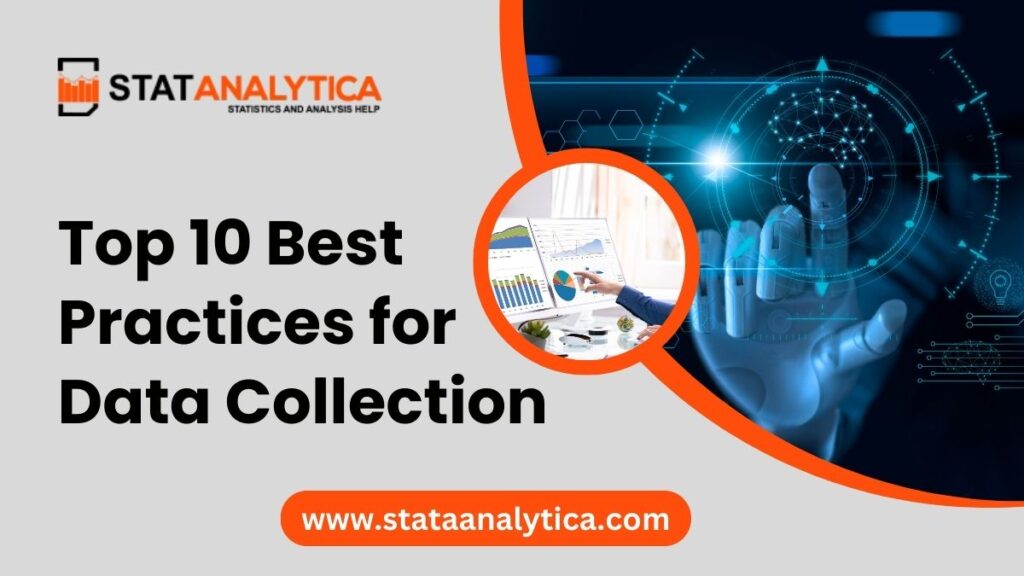In today’s data-driven world, collecting high-quality data is essential for making informed decisions, conducting research, and improving business operations. Organizations, researchers, and analysts rely on data to identify trends, improve customer experiences, and optimize strategies. However, poor data collection methods can lead to misleading results, privacy breaches, and unreliable conclusions.
To guarantee data integrity, organizations must collect data according to best practices. In this blog, we discuss the significance of accurate and moral data collection, as well as Best Practices for Data Collection to enhance the effectiveness and dependability of data collection procedures.
Understanding Data Collection
Table of Contents
What is Data Collection?
The process of obtaining and evaluating data on particular variables in order to identify patterns is known as data collecting., making decisions, or conducting research. The accuracy and quality of data collection directly impact the reliability of insights derived from it.
Types of Data Collection
There are two types of data collection:
- Quantitative Data Collection: Involves numerical data that can be measured, analyzed, and used for statistical interpretations. Examples include surveys, experiments, and automated data tracking.
- Qualitative Data Collection: Focuses on non-numerical data, such as opinions, behaviors, and experiee interviews, focus groups, and open-ended surveys.
Common Methods of Data Collection
- Surveys and Questionnaires: Collect structured responses from a large number of participants.
- Interviews: In-depth, one-on-one conversations to gather qualitative insights.
- Observations: Directly monitoring behaviors or interactions without interference.
- Experiments: Conducting controlled tests to evaluate hypotheses.
- Online Tracking & Analytics: Using digital tools to track user behavior and engagement.
Importance of Following Best Practices in Data Collection
1. Ensuring Data Accuracy and Reliability
High-quality data collection reduces errors and enhances the credibility of research or decision-making. Accurate data leads to better business strategies, efficient resource allocation, and improved problem-solving.
2. Maintaining Data Privacy and Security
As worries about data breaches and misuse grow, ensuring compliance with data protection regulations (e.g., GDPR, CCPA) is essential. Ethical data collection protects both organizations and individuals.
3. Enhancing Decision-Making with High-Quality Data
Reliable data provides actionable insights that can drive success in business, research, and policy-making. Organizations can use data-driven strategies to optimize operations, improve customer experiences, and stay competitive.
Best Practices for Data Collection
1. Define Clear Objectives Before Collecting Data
One of the most important steps in data collection is establishing well-defined objectives. Without a clear purpose, organizations risk collecting excessive or irrelevant data, which can lead to confusion and inefficiency. Before initiating any data collection process, it is essential to determine the specific problem or question the data will address. Clearly defining objectives ensures that only relevant and necessary information is gathered, minimizing redundancy and enhancing efficiency.
2. Choose the Right Data Collection Method
Choosing the right collection method is essential to getting precise and insightful information. The choice of method depends on the nature of the research, the target audience, and the available resources. Surveys and questionnaires are commonly used for large-scale data collection, offering structured and quantifiable responses. Interviews and focus groups, on the other hand, provide deeper insights into human behaviors, motivations, and opinions.
3. Ensure Data Accuracy and Reliability
Data integrity is fundamental to effective decision-making. If the collected data contains errors, inconsistencies, or biases, the resulting insights may be misleading. To enhance accuracy and reliability, organizations should use standardized data collection techniques and validation processes. Double-checking entries, cross-verifying data from multiple sources, and employing automated data validation tools can help minimize errors.
Additionally, it is essential to avoid ambiguity in survey questions and interview formats. Well-structured questions with clear response options prevent misinterpretation and ensure consistency in responses.
4. Maintain Data Privacy and Ethical Standards
With growing concerns about data privacy, organizations must prioritize ethical data collection practices. Collecting personal or sensitive information requires transparency and consent from participants. People should have the choice to opt-out if they so desire and be informed about how their data will be utilized. Avoiding legal penalties requires conformance to data protection laws like the California Consumer Privacy Act (CCPA) and the General Data Protection Regulation (GDPR).
5. Organize and Store Data Efficiently
Effective data management is just as important as data collection. Without proper organization, valuable information can become lost, duplicated, or misinterpreted. Organizations should implement a structured system for storing and categorizing data, making it easy to retrieve and analyze when needed. Cloud-based storage solutions, database management systems, and data warehouses help centralize and secure large datasets.
6. Minimize Bias and Errors in Data Collection
Bias in data collection can lead to inaccurate conclusions and skewed results. To mitigate bias, organizations should ensure that their sampling methods represent diverse demographics and perspectives. Randomized sampling techniques help prevent over-representation of specific groups, making the data more generalizable.
Additionally, survey and interview questions should be neutral and free from leading language that might influence responses.
7. Leverage Automation for Efficient Data Collection
The use of automation in data collection has revolutionized the way organizations gather and analyze information. AI-powered chatbots, machine learning algorithms, and automated tracking systems significantly cut down on the time and effort needed to gather data. By removing human mistakes, these technologies increase accuracy in addition to efficiency.
For example, businesses use Google Analytics and CRM software to track customer interactions in real-time, providing instant insights into consumer behavior.
8. Keep Data Up-to-Date and Relevant
Outdated or irrelevant data can lead to poor decision-making. Regularly updating databases and conducting periodic data audits help maintain data quality. Organizations should remove obsolete information, correct inaccuracies, and ensure that their datasets reflect current trends and conditions.
Up-to-date customer data ensures that businesses’ marketing strategies remain effective and targeted. Accurate and timely data also improves the validity of research findings.
9. Train Personnel Involved in Data Collection
Human error is one of the biggest challenges in data collection. Proper training for personnel involved in gathering, recording, and managing data significantly reduces inaccuracies. Employees should be educated on best practices, ethical considerations, and compliance with data protection laws.
Providing workshops and continuous learning opportunities ensures that data collection teams stay updated with evolving methodologies and technologies. A well-trained workforce improves the overall efficiency and credibility of the data collection process, leading to more reliable and actionable insights.
10. Analyze and Interpret Data Effectively
Collecting data is only the first step; meaningful analysis is essential to extract valuable insights. Organizations should use data visualization tools such as Tableau, Power BI, and Excel to identify patterns and trends. Statistical methods, machine learning models, and predictive analytics further enhance the interpretation of complex datasets.
Drawing actionable conclusions from data helps businesses optimize operations, researchers validate hypotheses, and policymakers make informed decisions. By investing in robust analytical tools and techniques, organizations can maximize the value of their collected data.
Challenges in Data Collection and How to Overcome Them
1. Ensuring Data Accuracy and Reliability
When collecting data, one of the most difficult tasks is making sure that the information gathered is accurate and reliable. Errors can arise due to human mistakes, biased sampling, or faulty data entry. To overcome this, organizations should implement standardized methods, automate data validation, and cross-check information from multiple sources. Using technology like AI-powered data verification tools can also help maintain accuracy and reduce errors.
2. Dealing with Low Response Rates
Many surveys and research studies face the issue of low response rates, as participants may be hesitant to share personal information. Privacy concerns, survey length, and lack of incentives often contribute to this problem. To improve response rates, organizations should ensure anonymity, offer small incentives, and keep surveys concise and engaging. Sending reminders and using multiple communication channels can also encourage participation.
3. Managing Large Data Volumes
As businesses and researchers collect vast amounts of data, organizing and managing it efficiently becomes a challenge. Without proper structure, data can become disorganized and difficult to analyze. Implementing data management tools, categorizing information systematically, and regularly cleaning datasets can improve efficiency. Cloud storage solutions and AI-driven analytics tools can further streamline data processing.
4. Addressing Privacy and Security Concerns
Organizations must guarantee safe data gathering and storage in light of escalating data privacy concerns and laws like the CCPA and GDPR. Data breaches can lead to legal penalties and loss of public trust. Best practices for data protection include encrypting sensitive data, limiting access to authorized users, and implementing Data Security Posture Management (DSPM) to support continuous threat detection and monitoring while maintaining compliance. Organizations should also educate employees on cybersecurity measures to minimize risks.
5. Reducing Sampling Bias
When the data gathered does not fairly represent the intended audience, sampling bias takes place, producing false insights. This issue can arise from unintentional selection bias or lack of diversity in data sources. To reduce bias, organizations should use random sampling techniques, set demographic quotas, and diversify data collection methods. Ensuring a well-balanced sample enhances the reliability of findings.
Conclusion
Effective data collection is the backbone of informed decision-making, research, and business success. By following best practices—such as defining clear objectives, choosing appropriate data collection methods, ensuring accuracy, maintaining privacy, and leveraging automation—organizations can efficiently collect high-quality data.
In an era where data fuels innovation and strategy, responsible data collection is not just a necessity but a competitive advantage. Whether you are a business, researcher, or data analyst, adopting these best practices will help you unlock valuable insights, protect user trust, and drive smarter decisions.
FAQs
What is the meaning of data collector?
A data collector is a person, tool, or system responsible for gathering, recording, and organizing data from various sources for analysis and decision-making. Data collectors can use methods such as surveys, interviews, observations, or automated software to collect information accurately and efficiently.
What is the most important factor in data collection?
Accuracy and reliability are the most important factors in ensuring the data is valid and useful for analysis.
What are common data collection methods?
Surveys, interviews, observations, experiments, and automated digital tools are widely used for data collection.


